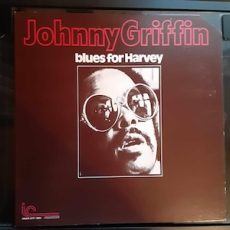
Requisites
Blues For Harvey ~ Johnny Griffin | By Eddie Carter
It’s been a while since I listened to one of my favorite tenor saxophonists, Johnny Griffin, so I chose an album that became the inspiration for this morning’s discussion. Blues For Harvey (SteepleChase Records SCS-1004) is an excellent 1973 live date, and Johnny’s working with a stellar supporting cast: Kenny Drew on piano, Mads Vinding on bass, and Ed Thigpen on drums. My copy is the 1976 U.S. Stereo reissue (Inner City IC 2004). Johnny began his career in the forties playing the alto sax. He changed to tenor after joining Lionel Hampton’s Orchestra, and he’s played with Art Blakey, Eddie “Lockjaw” Davis, Kenny Clarke-Francy Boland Big Band and Thelonious Monk, to name a few.
The quartet begins the set with a trip to That Party Upstairs, the first of four by Johnny Griffin. The ensemble’s melody begins at an easy swing before stepping aside for Johnny’s lengthy opening statement. Kenny takes an interesting turn next; then Mads finishes with a carefree stroll ahead of the foursome’s theme restatement and close. Alone Again is a pretty ballad that Kenny introduces gently segueing into Johnny’s delicately tasteful theme and opening chorus. The pianist follows with an elegantly stylish interpretation; then, Mads makes a few intimate remarks preceding Griff’s return for a touching theme reprise and finale.
Side Two starts with Soft and Furry. Griff and Mads open with a dialogue over Ed’s soft supplement into the quartet’s haunting theme. Johnny opens the solos with an exceptionally rich tone. Kenny takes an exquisite performance next, and then Mads gives a tender interpretation before the tenor and bass reappear to lead the foursome to a beautiful climax. Blues For Harvey is dedicated to the Montmartre bartender, Harvey Sand. Griff sets the tone in the introduction and the quartet’s melody. Johnny takes the lead in an incredibly fleet interpretation. Kenny adds a bit of fire and drive in the second reading, and Ed has a vigorous exchange with the leader, leading to the ensemble’s brisk conclusion.
Rhythm-A-Ning by Thelonious Monk starts with the foursome’s quirky theme before Johnny takes flight with a speedy interpretation that seamlessly switches to The Theme before the song ends with Griff’s introduction of the quartet. Johnny Griffin and Nils Winther produced Blues For Harvey, and Nils also did double duty behind the dials of the recording. The album’s sound quality is good for a seventies live date, placing the listener in the Montmartre audience, and the quartet’s performance is enjoyable throughout. If you’re a fan of Griff’s playing or in the mood for hard bop, I offer for your consideration, Blues For Harvey by Johnny Griffin. It’s a little-known release in his extensive discography deserving of greater recognition and worthy of checking out for a spot in your library!
© 2024 by Edward Thomas Carter
More Posts: choice,classic,collectible,collector,history,instrumental,jazz,music,saxophone
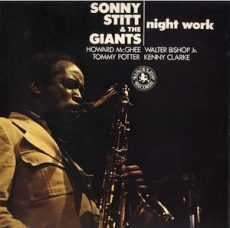
Requisites
Night Work ~ Sonny Stitt And The Giants | By Eddie Carter
As a teenager growing up in the late sixties and early seventies, I was exposed to and enjoyed many different jazz saxophonists, thanks to my Mom and my uncles Ben, Bob, Emmanuel, and Mr. Leo Mintz. Sonny Stitt has always been one of my favorites. He enters this morning’s spotlight with Night Work (Black Lion Records BLP 30154) by Sonny Stitt and The Giants. It was initially recorded in 1967 but not released until 1974. Sonny Stitt is featured on alto sax (A1, A2, B1, B4), and the other giants are Howard McGhee (tracks: A1, A2, B3, B4) on trumpet, Walter Bishop Jr. on piano, Tommy Potter on bass, and Kenny Clarke on drums. My copy is the U.S. Stereo release (Black Lion BL-307).
The opener, Night Work by Howard McGhee, is an upbeat invitation to sit back, relax and ride the rhythm of the ensemble’s swift melody into Sonny’s opening solo. Howard has the next spot and delivers the goods with considerable agility, followed by Walter’s impeccably delivered reading. Howard and Sonny join forces to exchange a few ideas together before Kenny joins their conversation, leading to the reprise and ending. Matter Horns by the team of Eiger and Jungfrau slows the pace to mid-tempo for Stitt’s easygoing theme and relaxing opening statement. Howard comes in next with a pleasantly flowing solo. Walter continues the bluesy groove in the third reading. Tommy and Kenny add a great deal of pleasure to the next two interpretations ahead of the quintet, trading a few riffs together before the climax.
The second side starts with a gorgeous quartet rendition of Loverman by Jimmy Davis, Roger Ramirez, and Jimmy Sherman. It is a beautiful jazz standard that Sonny and the rhythm section begin with their exquisite melody. Sonny captures the standard’s delicacy and tenderness in the song’s lone interpretation preceding the foursome’s elegant conclusion. Both horns take a break for the rhythm section’s lovely version of Satin Doll by Duke Ellington, Billy Strayhorn, and Johnny Mercer. Walter shows a great deal of respect to Duke as he leads the trio through the introduction and melody. He continues making a personal impression on the song’s solo while Tommy and Kenny provide the support ahead of the theme’s restatement and close.
Howard steps into the spotlight with the rhythm section for Don’t Blame Me by Jimmy McHugh and Dorothy Fields. The trumpeter’s piercing tone penetrates the introduction before settling down for a pretty melody. Howard has an exceptionally fine spot as the song’s only soloist, complemented by the trio’s accompaniment culminating in a tender finale. Hello by Howard McGhee brings the album to a close and this song will remind listeners of Milt Jackson’s Bags’ Groove. McGhee’s muted trumpet shares the duties with Stitt during the melody. McGhee steps up first with an excellent muted solo. Bishop gets something cooking in the second statement, and then Stitt takes the spotlight next. Clarke gets the last word in an exchange with both horns ahead of the theme’s reprise and ending.
Alan Bates produced Night Work, and Helmuth Kolbe was behind the dials of the recording. The album’s sound quality is quite good with a solid soundstage that transports the listener to the studio as the musicians are playing. Sonny Stitt was one of the best jazz saxophonists, with a career lasting nearly four decades and a recorded discography of over one hundred albums. He was also proficient on the tenor sax and baritone sax. This is one of his best records, in my opinion, and if you are in the mood for a great sax album, I invite you to check out Night Work by Sonny Stitt and The Giants on your next record-shopping trip. If you’re looking to start a collection of his music, it’s worth seeking out for your library and a title I’m sure you’ll enjoy!
~ Don’t Blame Me, Loverman, Satin Doll – Source: JazzStandards.com
© 2024 by Edward Thomas Carter
More Posts: choice,classic,collectible,collector,history,instrumental,jazz,music,saxophone
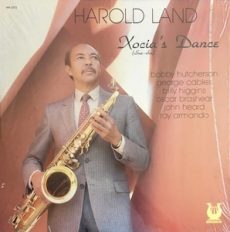
Requisites
Xocia’s Dance (Sue-sha’s Dance) ~ Harold Land | By Eddie Carter
Harold Land takes the stage for this morning’s discussion with an excellent hard bop album, Xocia’s Dance (Sue-sha’s Dance) (Muse Records MR 5272). He was one of the best West Coast tenor saxophonists during the fifties and sixties. His resume includes playing with the Clifford Brown/Max Roach Quintet, The Curtis Counce Group, The Gerald Wilson Orchestra, and The Timeless All-Stars. Xocia’s Dance reunites Harold with Bobby Hutcherson, who co-led a quintet with him thirteen years earlier. He is joined on this date by Oscar Brashear on flugelhorn (track: B2) and trumpet (A1 to A3), Bobby Hutcherson (A2, A3, B2) on vibes, George Cables on piano, John Heard on bass, Billy Higgins on drums, and Ray Armando (B1) on percussion. My copy is the original 1982 U.S. Stereo release.
Side One opens with Dark Mood, an original by Harold Land that is introduced by the trio ahead of the quintet’s lively theme. Harold gets things started, and then Oscar follows with a clearly inspired performance. George approaches the third reading with driving enthusiasm; then, all three soloists share a moment before the closing chorus and vibrant ending. Daisy Forever is a pretty tune by Oscar Brashear that Bobby gets started ahead of the group’s lovely melody. Brashear leads the way with a solo of seductive warmth; then, Land shows great care in the following reading. Hutcherson enters for the first time and delivers a beautiful interpretation. Cables provides the final gentle verses leading to the group’s closing chorus and slow dissolve.
Xocia’s Dance (Sue-sha’s Dance) comes from the pen of Harold Land, Jr., and the pace moves upward to a lively beat. The trio’s introduction heads toward the ensemble’s medium theme. Harold Sr. has the first solo and gets into a remarkable groove. Oscar answers him with a tasty reading as sweet as honey, and then George provides an exclamation point into the theme’s restatement and close. Side Two opens with Ah, I See, a beautiful tune by Charles Tolliver that starts with Harold’s and Bobby’s tranquil yet haunting theme. Land picks up the pace for a sweetly melodic opening statement, then gives way to Hutcherson’s delightful interpretation. Cables comes in softly and with feeling next before Harold returns for a restrained ending.
The album ends with a romantic postscript by Harold Land. To Lydia, With Love is a touching tribute to his wife and the mood is delicately expressed in the introduction and theme. Harold begins the opening solo lovingly, succeeded by Bobby’s equally thoughtful reading. Oscar’s flugelhorn delights with a beautiful statement. George conveys the feeling of everlasting love in a short anecdote ahead of the ensemble’s closing chorus and fadeout. Esmond Edwards produced Xocia’s Dance, and Jim Mooney was the recording engineer. The album’s sound quality is good, except for a bit of harshness during the piano solo on Ah, I See. The music, however, is terrific and quite capable of brightening anyone’s mood after a long day or week.
In addition to Xocia’s Dance, Harold Land recorded fourteen albums as a leader and appeared in some of the best jazz albums as a sideman. He co-led groups with Billy Higgins, Blue Mitchell, and Red Mitchell. Land later became a professor at the University of California and joined the UCLA Jazz Studies. He passed away on July 27, 2001, from a stroke at age seventy-two but is still remembered as a brilliant improviser and one of the best to play the tenor sax. If you’re a fan of West Coast jazz, I invite you to check out Xocia’s Dance (Sue-sha’s Dance) by Harold Land on your next record shopping trip. It’s a hidden gem in his discography and a personally satisfying album that I can happily recommend for a spot in your library!
~ Harold Land – Source: Wikipedia.org © 2024 by Edward Thomas CarterMore Posts: choice,classic,collectible,collector,history,instrumental,jazz,music,saxophone
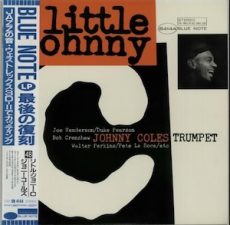
Requisites
Little Johnny C ~ Johnny Coles | By Eddie Carter
It happened like this: after listening to Bass on Top, my memories of my mom led me to another of her favorite jazz albums. Little Johnny C (Blue Note BLP 4144/BST 84144) by Johnny Coles is the trumpeter’s second release as a leader and his only Blue Note session. It was recorded in 1963 and released the following year. Johnny’s joined on this hard bop date by Leo Wright on alto sax (tracks: A1 to A3, B2, B3) and flute (B1), Joe Henderson on tenor sax, Duke Pearson on piano, Bob Cranshaw on bass, Walter Perkins (A1 to A3), and Pete La Roca (B1 to B3) on drums. My copy is the 1990 Toshiba EMI Japanese Stereo reissue sharing the original catalog number.
Little Johnny C is the first of five tunes by Duke Pearson. It kicks off Side One at a fast tempo with Duke’s brisk introduction to the front line’s lively theme. Leo comes out cooking first; then Johnny steps swiftly into the second statement. Joe wails in the following solo; then Duke shows his impressive skills into the group’s climax. Hobo Joe by Joe Henderson is a Latin-flavored blues that opens with the trio’s introduction, ahead of the sextet’s easy going melody. Coles begins this pleasant trip; then, Pearson picks up the next part of the journey. Wright continues the leisurely caravan, and Henderson concludes the trek in a fine finale ahead of the theme’s return and the trio’s fadeout.
Jano picks up the beat to end the first side with the ensemble’s medium melody. Leo sets the scene in the opening solo. Johnny takes over for a lengthy reading; then Joe builds the third statement exquisitely. Duke provides the closing remarks before the group returns to take the song out. My Secret Passion is a pretty ballad taken at a medium bounce, with Johnny leading the sextet in the melody and Pete La Roca taking over on drums. Coles opens the solos with a warm tone. Henderson displays delicacy and sensitivity in the following reading. Wright comes in next on the flute and gives a heartwarming statement. Pearson’s soulful interpretation brings us back to the reprise and ending.
Heavy Legs delivers an upbeat invitation to relax and enjoy the sextet’s ride through the opening chorus. Johnny is concise and to the point in the first reading. Joe follows with an equally enjoyable solo; then Leo steps in next for a rousing interpretation. Duke brings the solos to a happy conclusion ahead of the sextet’s theme restatement, slowly dissolving into nothingness. So Sweet My Little Girl is Pearson’s tribute to his then seven-year-old daughter, Cynthia. Johnny starts the melody softly with the saxes in the background. It sets the scene for the pianist’s tender performance as the song’s only soloist, leading to the front line’s return for a gentle climax.
Alfred Lion produced Little Johnny C and Rudy Van Gelder was the man behind the dials of the recording. The album sounds amazing, with a stellar soundstage that’s so good you’ll think you’re in the studio with the musicians as they are playing. Toshiba EMI did an excellent job with this reissue and the record is also very quiet until the music starts. Johnny only recorded five albums as a leader but has an extensive discography as a sideman. If you’re a hard bop fan and unfamiliar with Johnny Coles, I invite you to look out for Little Johnny C on your next record shop visit. It’s simply a great jazz album that I’m sure would make a perfect addition to any library and become a favorite on your turntable!
© 2024 by Edward Thomas Carter
More Posts: choice,classic,collectible,collector,history,instrumental,jazz,music,trumpet
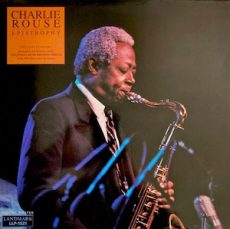
Requisites
Epistrophy: The Last Concert ~ Charlie Rouse | By Eddie Carter
Charlie Rouse was one of jazz’s great musicians, but he is best known as the tenor saxophonist in The Thelonious Monk Quartet for eleven years. He enters this morning’s spotlight with Epistrophy–The Last Concert (Landmark Records LLP-1521). The album honors the pianist and was recorded live at The Thelonious Monk Birthday Tribute during the Jazz in The City Festival. His bandmates for this exceptional performance are Don Cherry (tracks: B1, B2) on trumpet, Buddy Montgomery (B1, B2) on vibes, George Cables (A2, A3, B1, B2), and Jessica Williams (A4) on piano, Jeff Chambers on bass, and Ralph Penland on drums. Orrin Keepnews is the host. My copy is the 1989 U.S. Stereo release.
Orrin opens with a few words about Charlie Rouse before introducing him; then, the two men share Some Words About Monk that are just as entertaining as the music that follows. Nutty is taken at a medium tempo, and Charlie swings easily on the theme and the first solo. George picks up the groove and gets into something interesting; then Ralph shares the finale with Rouse and Cables preceding the ending. Ruby, My Dear is named after Monk’s first love, Rubie Richardson and is one of his most beautiful tunes. Charlie and the trio tenderly begin the melody. Rouse continues delivering the opening solo with sultry notes from his tenor sax. George compliments him with elegant execution in a short statement. Charlie adds a few final gentle touches before the closing chorus and the delight of the crowd.
Blue Monk was Monk’s personal favorite of all his compositions. Jessica takes over on piano and opens with a quirky introduction to the foursome’s bluesy melody. Charlie takes the lead solo with a relaxing informality that flows naturally. Jessica takes a comfortable ride in the second reading, and Jeff has an enjoyable moment in the closer, preceding the theme’s restatement and close. ‘Round Midnight by Thelonious Monk, Cootie Williams and Bernie Hanighen is Monk’s best-known and most recorded creation. George starts with a lengthy introduction, segueing into the trio’s gorgeous melody and the pianist’s opening solo. Buddy comes in next for a touching interpretation, and then Don expresses his thoughts in a haunting, muted performance. Charlie provides the pretty exclamation point ahead of the climax.
Epistrophy by Thelonious Monk and Kenny Clarke was the pianist’s closing number at each live set. George sets everything in motion for the ensemble’s lively melody. Don opens with a few twists and turns; then Charlie wails with ease next. Buddy answers with a spirited performance. George adds to the excitement, and Don, Charlie, and Buddy swap notes with Ralph ahead of the reprise and close, which receives abundant applause from the audience. Orrin Keepnews produced the album, and Ron Davis was the recording engineer. David Luke was the digital engineer, and the mastering was by George Horn. The album’s sound quality is stunning with an excellent soundstage that takes the listener to the club to enjoy the musicians as they are performing.
Epistrophy-The Last Concert is dedicated to Charlie Rouse’s memory and is the last album he recorded before his death from lung cancer seven weeks later on November 30, 1988. He was only sixty-four but leaves behind a legacy of thirteen albums as a leader. He also co-founded and recorded six albums with the group Sphere (Thelonious’ middle name). He also made quite a few titles as a sideman, including twenty-four with Thelonious Monk during his lifetime. Palo Alto was recorded in 1968 but not released until 2020. If you’re a fan of Monk’s music or Post Bop, I offer for your consideration, Epistrophy–The Last Concert by Charlie Rouse the next time you visit your favorite record shop. It’s one of the most enjoyable albums I’ve heard and is a title I’m sure you won’t regret adding to your library!
~ Palo Alto (Impulse B0032181-01) – Source: Discogs.com ~ Blue Monk, ‘Round Midnight – Source:JazzStandards.com ~ Epistrophy, Ruby, My Dear – Source: Wikipedia.org © 2024 by Edward Thomas Carter***In Like Bud which is included in the YouTube version of the album, is only available on compact disc and not on the original wax recording.
More Posts: choice,classic,collectible,collector,history,instrumental,jazz,music,saxophone


